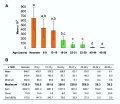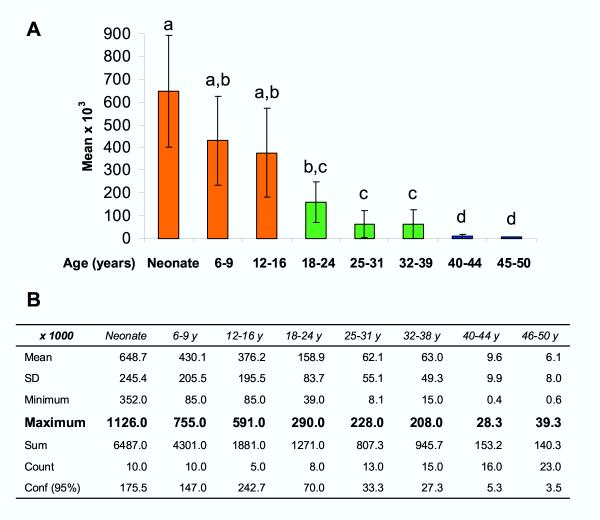File:Human- ovary age primary follicle numbers.jpg
Human-_ovary_age_primary_follicle_numbers.jpg (600 × 520 pixels, file size: 36 KB, MIME type: image/jpeg)
A) Statistical analysis of transformed cumulative data [Y = Log(Y)] reported by Block [53,63,64] and Gougeon [54] shows P < 0.0001 for one-way ANOVA. Tukey-Kramer Multiple Comparison post-test revealed that compared to neonatal ovaries a significant difference in follicle number first appears in the age group of 18 to 24 years. However, no significant difference was observed during the 20 years of optimal reproductive period, between females 18–38 years of age. Yet, the ovaries obtained from 40–50 year old females showed a significantly lower number of primary follicles vs. all other age groups.
B) Descriptive statistics indicates plateau of the maximum follicle numbers (highlighted) during the 6–16, 18–38, and 40–50 age periods, associated with a lack of statistical significance between mean values ± SD – see panel (A).
Original file name: 1477-7827-2-20-15.jpg
Reference
<pubmed>15115550</pubmed>
Origin of germ cells and formation of new primary follicles in adult human ovaries. Bukovsky A, Caudle MR, Svetlikova M, Upadhyaya NB. Reprod Biol Endocrinol. 2004 Apr 28;2:20. PMID: 15115550 | Reprod Biol Endocrinol.
Bukovsky et al. Reproductive Biology and Endocrinology 2004 2:20 doi:10.1186/1477-7827-2-20 http://www.rbej.com/content/2/1/20
© 2004 Bukovsky et al; licensee BioMed Central Ltd. This is an Open Access article: verbatim copying and redistribution of this article are permitted in all media for any purpose, provided this notice is preserved along with the article's original URL.
File history
Click on a date/time to view the file as it appeared at that time.
| Date/Time | Thumbnail | Dimensions | User | Comment | |
|---|---|---|---|---|---|
| current | 01:55, 18 April 2010 |  | 600 × 520 (36 KB) | S8600021 (talk | contribs) | Age-related changes in primary follicle numbers in both human ovaries (A) and descriptive statistics (B). A) Statistical analysis of transformed cumulative data [Y = Log(Y)] reported by Block [53,63,64] and Gougeon [54] shows P < 0.0001 for one-way ANOV |
You cannot overwrite this file.
File usage
The following 2 pages use this file:
